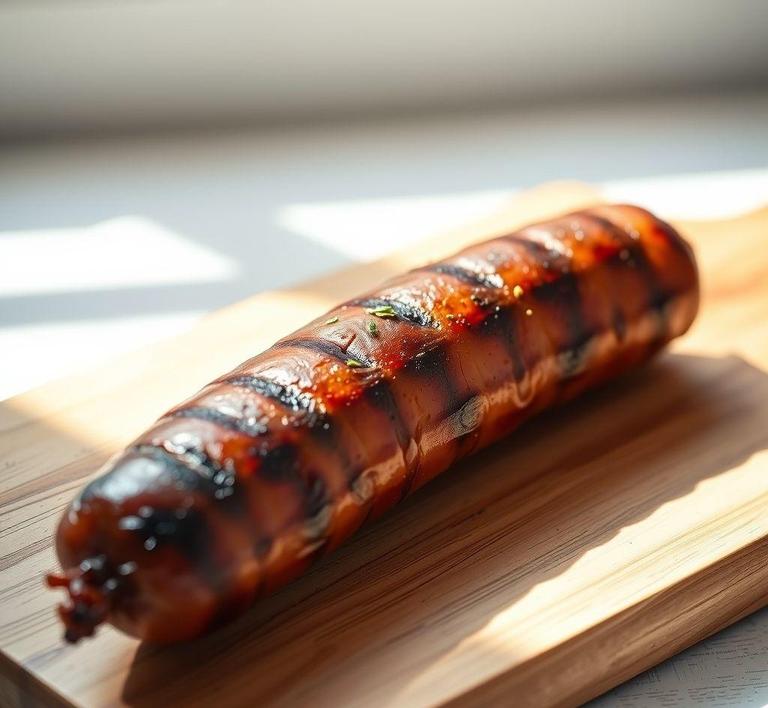When it comes to storing smoked sausage, many people are unsure whether they can refreeze it once it has been thawed. While smoked sausage is a durable food item, knowing how to handle it properly is essential for maintaining both its quality and safety. Refreezing smoked sausage can be done, but there are a few key tips to keep in mind to prevent loss of flavor or texture. From understanding the right storage methods to knowing how long it can last in the freezer, this guide will walk you through the best practices for refreezing smoked sausage so you can enjoy it without worry.
Can You Refreeze Smoked Sausage?

Refreezing smoked sausage is a question that often comes up in households, particularly for those who like to stock up on meats or deal with leftovers. The simple answer is yes, you can refreeze smoked sausage-but with certain conditions and considerations.
Smoked sausage is typically preserved through a combination of smoking and curing, which helps to extend its shelf life. This process not only imparts a distinct, rich flavor but also contributes to the sausage’s ability to withstand freezing and thawing. However, refreezing isn’t always straightforward, especially when it comes to maintaining quality and safety.
When you freeze smoked sausage, the goal is to preserve its freshness and taste. Freezing halts bacterial growth and slows down the deterioration process, keeping it safe to eat for a longer time. However, once thawed, moisture and texture can be compromised. When you refreeze smoked sausage, the sausage is subjected to additional cycles of freezing and thawing, which can degrade its texture and quality.
How To Refreeze Smoked Sausage?
Refreezing smoked sausage requires careful handling to ensure the best outcome. Below are some key steps to follow if you plan to refreeze it:
- Thaw Properly: Before refreezing, you need to ensure the sausage is properly thawed. This should be done in the refrigerator, not at room temperature, as thawing at room temperature can lead to bacterial growth. Ideally, let the sausage thaw slowly over 12-24 hours in the fridge.
- Check the Quality: Assess the sausage for any signs of spoilage before refreezing. If it has any off smells, sliminess, or discoloration, discard it. Refreezing already compromised sausage will only lead to more deterioration. Smoked sausage that has been left at room temperature for more than two hours should also be discarded.
- Portion and Wrap Well: If you plan to refreeze the sausage in portions, make sure to divide it into smaller, meal-sized servings. Wrap each portion tightly in plastic wrap or aluminum foil. A vacuum-seal bag or freezer-safe Ziploc bag is also an excellent option, as it will reduce the amount of air around the sausage, minimizing freezer burn and preserving its quality for longer.
- Label and Date: Clearly label the packaging with the date and content. This way, you’ll know when it was originally frozen, helping you track how long it’s been stored. Sausage should not be refrozen more than once for the best results.
- Freeze Quickly: Place the wrapped sausage back in the freezer as soon as possible after wrapping. The faster it freezes, the less time the sausage will spend in the “danger zone” (between 40°F and 140°F), where bacteria can thrive. The freezer temperature should be set to 0°F (-18°C) or lower.
Quality Impact
While refreezing smoked sausage is safe as long as proper procedures are followed, it is essential to understand that the quality may be impacted. Several factors contribute to this:
- Texture Loss: When sausage is frozen, the water inside it forms ice crystals. These ice crystals can rupture the cells in the sausage, which alters its texture when it’s thawed. Upon refreezing, the process of freezing and thawing again can cause further texture degradation. This can result in the sausage becoming mushy or dry when cooked, particularly if it is not sealed properly or stored too long.
- Flavor Deterioration: Smoked sausage has a robust flavor thanks to the smoking process. However, repeated freezing can cause a gradual loss of flavor intensity. The seasonings and smoky taste may not be as vibrant after multiple freeze-thaw cycles, leaving the sausage tasting flat or bland. The high-fat content in smoked sausage can also affect the flavor, as fats can go rancid over time, especially when exposed to air and fluctuating temperatures.
- Moisture Loss: Every time the sausage goes through a freeze-thaw cycle, it loses some of its moisture content. This can affect the juiciness of the sausage when cooked, making it less appealing. While smoked sausage tends to retain moisture better than other types of sausage, the cumulative effect of freezing and thawing can lead to a drier end product.
- Freezer Burn: If the sausage isn’t properly sealed, it’s prone to freezer burn, which occurs when air gets trapped in the packaging and dries out the surface of the sausage. Freezer-burned sausage will have dry, discolored spots and a texture that’s unpleasant to eat. While freezer burn doesn’t make the sausage unsafe to eat, it will certainly affect its taste and mouthfeel.
- Nutritional Value: Nutritionally, refreezing smoked sausage doesn’t cause any significant losses in terms of proteins or fat content. However, the quality of vitamins and other nutrients can degrade slightly with each freeze-thaw cycle. While this is typically not a major concern, it’s something to keep in mind if you’re refreezing multiple times.
While it is safe to refreeze smoked sausage as long as it’s done with care, it’s important to understand that the quality of the sausage may decline with each freeze-thaw cycle. Refreezing can affect the sausage’s texture, flavor, moisture content, and may lead to freezer burn if not stored properly. To ensure the best results, be sure to follow the proper thawing, wrapping, and storage techniques outlined above. And, while the sausage may still be safe to eat after being refrozen, the eating experience might not be as pleasant as when it was first frozen. If you’re concerned about quality, it’s always best to limit how many times the sausage goes through the freezing and thawing process to maintain its best flavor and texture.
Is It Safe To Refreeze Smoked Sausage?
Refreezing smoked sausage can be a somewhat tricky subject, as there are a few factors that determine whether it’s safe or not. In general, refreezing smoked sausage is possible, but it comes with a few important considerations related to quality and safety.
Smoked sausage, which is typically pre-cooked or cured through a smoking process, can usually be refrozen if it was initially frozen and then thawed safely. The key here is to ensure that the sausage has been handled correctly at every stage-during the initial freezing, thawing, and refreezing process.
When freezing any type of meat, including smoked sausage, it’s crucial to freeze it as soon as possible after purchase to lock in freshness. If you thaw smoked sausage in the refrigerator, it can generally be refrozen within a short time frame (usually within 1-2 days), provided it has remained at a safe temperature (below 40°F or 4°C) during thawing.
However, if the sausage was thawed at room temperature for a prolonged period, refreezing it could result in foodborne illness, as bacteria can grow rapidly in the "danger zone" (40°F-140°F or 4°C-60°C). So, safety is your primary concern when considering whether or not to refreeze smoked sausage.
Signs That Smoked Sausage Should Not Be Refrozen
There are a few red flags that should immediately make you reconsider refreezing smoked sausage:
- Thawed for Too Long at Room Temperature: If your smoked sausage has been left out at room temperature for more than 2 hours (or 1 hour if the temperature is above 90°F/32°C), it’s best to discard it. Bacteria multiply quickly in this range, making the sausage unsafe to refreeze or consume.
- Unpleasant Smell or Sour Odor: If the sausage has an off-putting or sour smell, this is a clear indication that it has spoiled. Once this happens, the risk of foodborne illness increases dramatically, and refreezing will only preserve the bacteria in the sausage, making it dangerous to eat later.
- Slimy Texture or Discoloration: If you notice a slimy film forming on the sausage or if it has changed color (becoming dull, grayish, or green), it’s no longer safe to eat. These signs suggest that the sausage has started to deteriorate due to bacterial growth, and refreezing it won’t reverse these effects.
- Sausage Was Not Thawed Properly: If the sausage was thawed in warm water or in a microwave (as opposed to a fridge), the temperature fluctuations may have encouraged bacterial growth. Once thawed this way, it’s best not to refreeze the sausage as it could lead to foodborne illness.
Common Refreezing Mistakes
When it comes to refreezing smoked sausage, there are several mistakes people often make that can compromise both safety and quality:
- Refreezing Multiple Times: One of the biggest mistakes is refreezing the sausage multiple times. Every time you thaw and refreeze, the quality of the sausage diminishes due to moisture loss, texture changes, and potential bacterial growth. It’s best to limit the number of times you freeze and thaw smoked sausage.
- Thawing at Room Temperature: Thawing smoked sausage at room temperature can allow bacteria to multiply rapidly, increasing the risk of foodborne illness. The safest method for thawing frozen sausage is to place it in the fridge, where it stays at a controlled temperature.
- Refreezing Without Proper Packaging: Another common mistake is refreezing smoked sausage in the original packaging, which might not be airtight. If the sausage is not wrapped securely, it could absorb odors from the freezer or develop freezer burn. It’s important to rewrap the sausage tightly in plastic wrap or freezer paper and then place it in an airtight freezer bag or container.
- Refreezing Sausage That Was Cooked Before Freezing: If you initially cooked the sausage before freezing, then thawed it and cooked it again, you’re introducing extra steps that could make the sausage dry and tough. While it’s still technically safe to refreeze cooked sausage, the extra handling could result in a less enjoyable eating experience.
Tips And Tricks
- Label and Date Your Sausage: One of the best practices for safe food storage and refreezing is to clearly label and date your sausage before freezing it. This way, you can keep track of how long it’s been frozen and ensure you’re not keeping it too long in the freezer, which can lead to a decrease in quality.
- Freeze in Portions: If you know you won’t use the entire package of smoked sausage in one go, consider freezing it in smaller portions. This prevents you from having to thaw and refreeze the entire batch each time you want a meal, which helps maintain the sausage’s quality.
- Avoid Freezer Burn: Freezer burn is caused by air exposure, which dehydrates the sausage. To avoid this, make sure that the sausage is wrapped securely in heavy-duty freezer bags or plastic wrap. If using a vacuum sealer, that’s even better for keeping the sausage fresh.
- Thaw in the Refrigerator: To safely thaw smoked sausage, always use the refrigerator. While it might take a little longer, it’s the safest way to ensure that bacteria don’t have the chance to multiply.
- Cook Before Refreezing: If you’ve thawed smoked sausage and realize you won’t use it in time, you can cook it before refreezing. Cooking it will kill any bacteria that may have developed during thawing, making it safer to refreeze. However, keep in mind that the texture and flavor may be affected after the second freeze.
- Use within a Reasonable Time Frame: Even though you can refreeze smoked sausage, it’s best to consume it within a reasonable amount of time. While the sausage can remain safe in the freezer for months, the quality will begin to degrade after about 2-3 months.
Conclusion
Refreezing smoked sausage is possible, but there are important factors to consider for both safety and quality. While it’s safe to refreeze smoked sausage as long as it has been handled correctly-thawed in the fridge, not left at room temperature for too long, and properly sealed-repeated freezing and thawing can impact the sausage’s flavor, texture, and overall quality. Signs of spoilage, such as off smells, discoloration, or sliminess, are clear indicators that refreezing is no longer an option, and the sausage should be discarded.
By following proper food safety practices, such as thawing in the refrigerator, avoiding multiple refreezing cycles, and storing the sausage in airtight packaging, you can preserve the sausage’s quality and enjoy it without unnecessary risk. Whether you’re freezing smoked sausage for future meals or deciding if it’s still safe to eat, being mindful of how you store and handle it will make all the difference in ensuring a safe and tasty experience.


